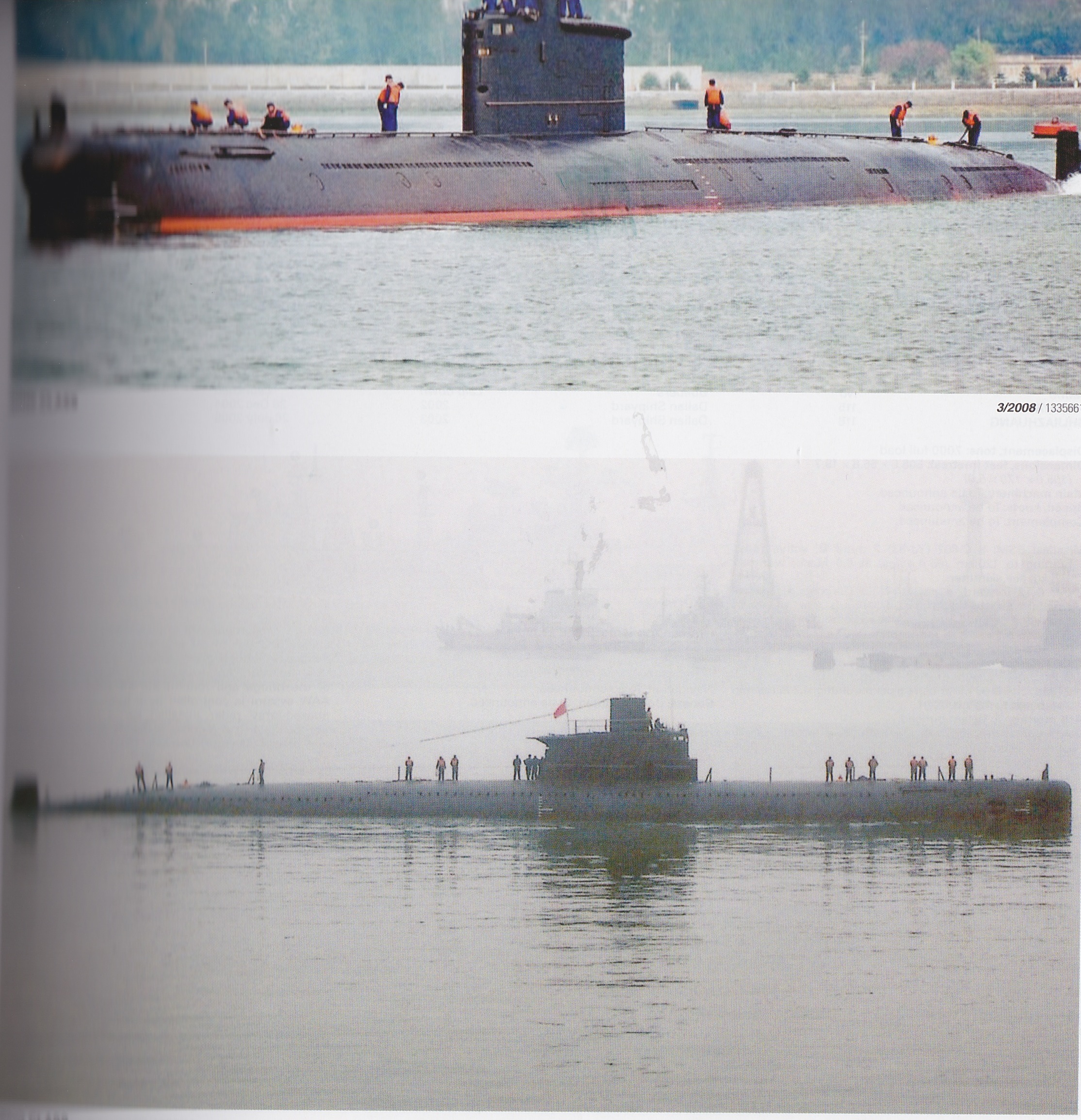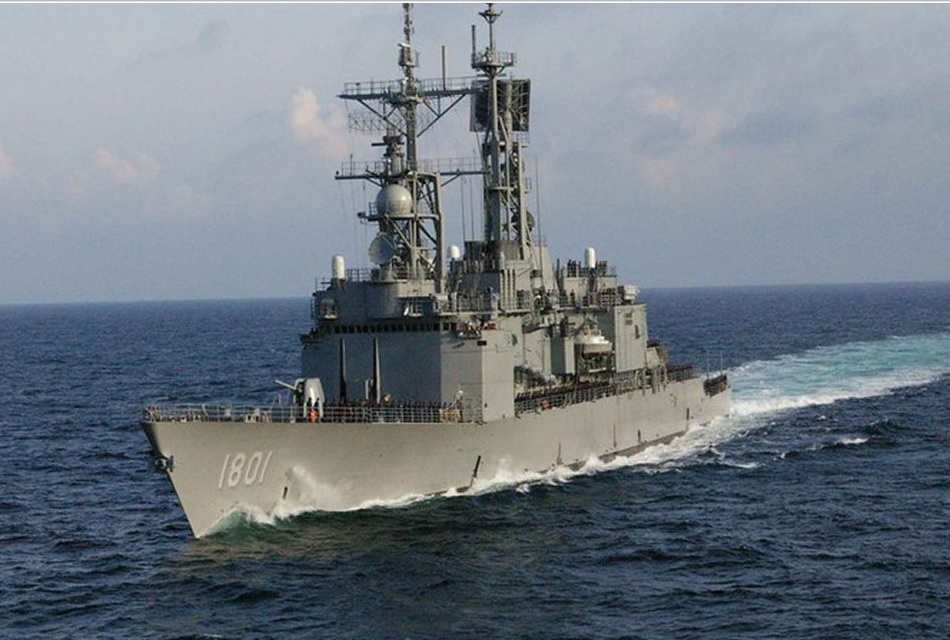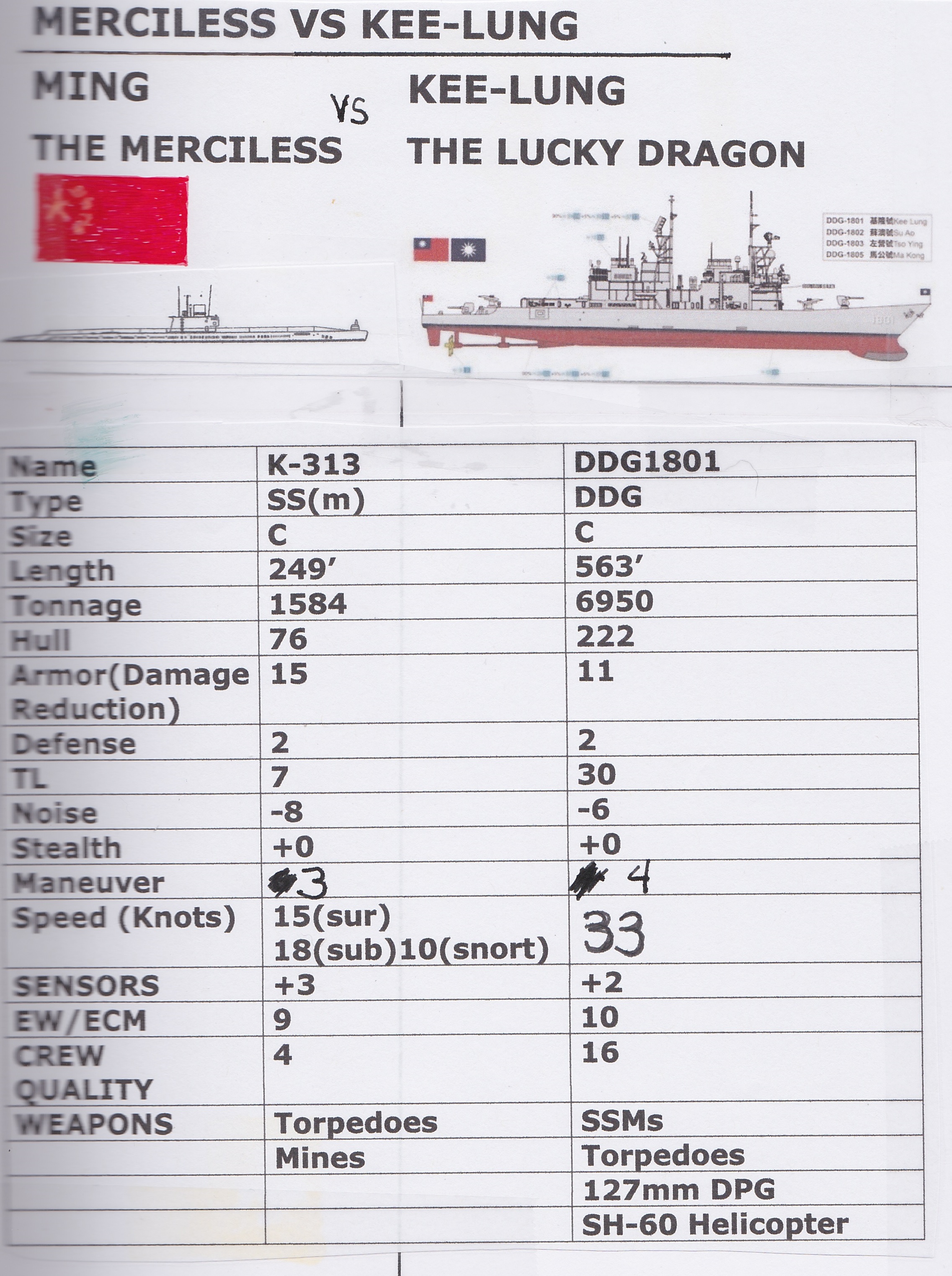


LOG SUMMARY
0401 Began laying mines as ordered north west Taipei harbor starting at 0001 as per orders.
Should be placing last mine shortly and will rig for silent running.
Crew is performing well and should be elevated past their "Conscript Status" after this mission.
Crew will be transferred to fill in on the newer boats and I will get a new crew of conscripts, I wish them well on their new vessels. With the current situation as it is maybe I will be promoted as well.
0415 One of our mines have detonated. I order the 313 to periscope level for a look.
0430 Confirmed container vessel was hit by one of our mines. Orders a torpedo loaded to finish it off . Just need to move into position for an acceptable launch vector.
0435 Active sonar pings detected. ROCN vessel must be near by. Working on a targeting solution.
0440 Target confirmed, sonar identified screw sound to be a ROCN DDG, Lung Class. Moving into position for a torpedo launch on DDG
0445 Torpedo launched, diving for thermal layer, going silent.
END LOG
ROCN DDG Kee Lung
[ Kee Lung was formerly the American guided missile destroyer USS Scott DDG-995, which was decommissioned by the United States Navy in 1998. Scott was sold to the Republic of China (Taiwan) Navy along with three other American Kidd-class destroyers in 2001. Scott was then renamed to Kee Long and was the first of the four ships to be commissioned in the Republic of China Navy which made her the lead ship in the Republic of China Navy. For a period of time Kee Lung was tentatively named Chi Teh (紀德), a translates roughly to Kidd in Chinese. It was later decided to name her after the port of Keelung, the main seaport for Taiwan’s Capital Taipei and, a major naval port in northern Taiwan.
Kee Lung, along with her three sister ships, were the largest destroyers in displacement in the Republic of China Navy service. Kee Lung was re-fitted for service in the ROCN and formally commissioned on 17 December 2005 along with her sister ships. Kee Lung was the only one of her sister ships to be equipped with the LAMPS III flight deck system. This enables Kee Lung to carry up to two of the more capable Seahawk helicopters for anti-submarine warfare, which may have been why she alone of her sister ships survived the conflict of the three dragons.
I sat down with the ship’s captain for an interview shortly after the end of hostilities. His ship’s defense of Taiwan’s northern water ways is now widely accepted as part of the first action in the war.]
“We were patrolling the approaches to Taipei’s North East sea lane between Taipei and Kagoshima Japan the night the war started. The ROCN had been on heightened readiness ever since the earlier that year in January. It started just like it did back in 1996 with Beijing sending a message to the Taiwanese electorate by conducting a massive series of missile tests in the waters surrounding Taiwan.
I was visiting with my 1st officer as he was the officer of the deck on the bridge during the “Last Dog Watch”. I had just been to the CIC, that’s the ship’s Command Information Center, which is below the bridge where the ship’s radio, radar and sonar operators had reported all quite.
‘Number One’ and I were discussing the new restaurant he had taken his wife to a week before and I remember he was recommending some dishes he thought my wife would like.”
“Are you and all the officers of the Lung this close? Are you always so casual with your men?” I had to ask, knowing various military men, some liked to keep colleagues at a professional distance, others did not. In practice neither style was better nor worse, it was more of how the commanding officers implemented the style that would make it work, or not. I continued, “Is the Kee Lung a happy ship?”
“Oh yes,” he replied. “I doubt we would have survived if we had been a conflicted ship. We were a seasoned crew which was part of it. Many of the brand new destroyers with their new crews were totally, what’s the word my American counterparts like to say, ‘Green’. A high intensity conflict is a bad time to be, ‘breaking people in,’ as they say. We all knew our jobs, and did them without, ‘drama’.”
“So is that when the first destress call came in?”
The captain’s face became grave. “Yes, that’s when the chief radio operator called in from the CIC. One of the big Evergreen Lines container vessels had hit, or been hit by something.”
“What happened then?”
“I ordered general quarters and ordered the navigator to plot a course for the stricken vessel. In the back of my mind I was thinking, could it be the mainlander be launching missiles now at ships? If only it had been that. Luckily I had ordered our speed to be reduced. At the time it was more of a precaution as we were entering a busy sea lane. The idea is that you will have more time to react to oncoming vessels both commercial and military that use the route and many were less vigilant than they should be these days relying too heavily on automated systems like your Navy’s Destroyer McCain did when it had its collision back in 2017. I ordered all the ship’s sensors to full readiness. Again I was thinking random incoming missiles like we had in the last strait crisis. The Stricken ship was less than 20 kilometers away and the message said they were in no immediate risk of sinking. If we had been moving faster our sonar operators would not have discovered the mines.”
“Is that when you discovered the People’s Republic of China’s Ming submarine?”
“Not right away. Sonar works better at slower speeds, especially for surface vessels. We were going just slow enough as we made our approach to the stricken container vessel for the sonar man to positively identify a string of objects running perpendicular the now stopped merchant vessel. After I confirmed this, I had my radar operators confirm that no aircraft of any kind, missiles, planes, drones, or otherwise had been detected. They confirmed this as well. That left only submarines. I ordered the Helicopters, which luckily were equipped for ASW or Anti-Submarine Warfare to be readied and launched as soon as possible. I slowed the Lung further and ordered us to run parallel to the row of mines. I confirmed that there was indeed just one row of 9 mines. Most mine fields are deployed in twin or several rows which I surmised, correctly that the big merchantmen must have blundered into the submarine just as she was getting started. It had been less than an hour since the container vessel had hit its mine so I guessed, again correctly that the submarine was still out there.”
“Did you warn the Evergreen Lines container vessel?”
“They were pretty quiet after we signaled them to stand by. I imagine the vessel’s captain was beginning to realize what had happened to them as well. Any captain that has been sailing these waters since the 1990s knew to expect trouble, especially since the PRC declared the 1st and 2nd island chains to be their own.”
“You’re referring to the PRC’s claims to the south china sea?”
“That’s the first chain, which includes Philippines. The Guam island chain all the way down to Indonesia is the second. They claimed all of it based on some 14th century maps the then Chinese emperor had made. They had been militarizing islands in the South China Sea now for decades and building up their navy to make those maps, and their ‘One China policy’ a realty.
Back to the submarine. In modern naval warfare, he who hits first usually wins. The only way to hit first is to know where the enemy is before he knows where you are. Please remember, that at that moment we were not at war, at least we did not consider ourselves in a shooting war, not yet, so I was not going to fire the first shot. That said, I was understanding ROCN protocol to defend the ship and the vessels under our protection in our waters if attacked. We launched both our helicopters and began searching for the submarine.”
“Was it hard to find?”
“Not as hard as many that study the field of naval warfare would have thought. Diesel –electric submarines can be very quiet indeed. This one however was one of the Type 035s, NATO code named Ming class boats, they are what the PRC liked to refer to as ‘new wine in an old bottle’. The original design dates back to the soviets in the early 1950s. The PRC and their People’s Liberation Army Navy had updated the design in the late 1990s, but by now even the newest boats of this class were still almost two decades old. Between the two helicopters and the Lung we soon triangulated were the submarine was and then started actively ‘pinging’ it with sonar to let it know we had found them. Again, if we had known the crisis had gone ‘hot’ we would have just sunk the boat immediately. “
“Is that when the Ming fired a torpedo?”
“Correct, the sonar operators immediately reported it and its location. I ordered counter measures deployed immediately and had the Lung do an evasive turn away from the row of mines. Unfortunately we swung close enough to set one off. It wasn’t a direct hit and the Kee Lung ‘s hull only took some minor dents, but for the damage to the port rudder we could have stayed at sea. This actually tirned out to be a blessing in disguise because of the damage she was not present for the battle for the strait. The immediate outcome from the quick maneuver was that it took us away from the oncoming torpedo. It was an older model, like the submarine that launched it, copied from an even older soviet design so the counter measures worked. I then ordered one of our helicopters to drop one of our own homing torpedoes. Just one. Again, I didn’t want the submarine destroyed I wanted it surfaced and captured at this point. Our torpedo did the job, and the Ming did surface.
The damage however was sever. Our torpedo had blown the stern off. I had hoped to tow the Ming into port, but I had to be happy with the capture of its crew. At the time I was terrified that the main land would raise a diplomatic stink, wanting my blood for the destruction of one of their boats, regardless of their own boats activities.
After we rescued the Ming’s crew and had them safely under guard we returned our attention to the stricken container vessel. A sea going tug had arrived and we escorted the three of them into port. It wasn’t until the next morning that we realized Taiwan was not only in a full scale war but a fight for its very existence.”